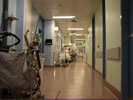

Health care facilities and hospitals present unique challenges when it comes to security. The sheer volume of traffic and staffing at a major health care facility rivals any other type of campus environment. Whether the need is to restrict access to authorised personnel-only areas or protect personal and private patient information in either electronic or paper formats or keep hygiene standards to the maximum level, security within the confines of a health care-related setting is multifaceted. It requires knowledge of current and future physical and logical access needs, coupled with an understanding of the standards and regulations facing today’s health care practitioners.
For years, health care facilities have used a variety of methods to provide individuals with convenient yet secure access to facilities, PCs and the networks. Because building access and IT systems have traditionally been separate purchasing decisions for many organisations, health care employees are familiar with being forced to carry multiple cards or tokens and/or using multiple PINs or passwords to access various systems. These practices resulted in systems that are cumbersome for the employee to use and difficult and costly for the organisation to manage and maintain, not to mention, deadly within an emergency setting.
Contactless multitechnology cards
Hospital staff needs access to many different areas within the facility, as well as immediate PC access and permission to access confidential client records. Carrying multiple smartcards to access those areas does not help mobility, speed or convenience for staff.
Utilising both contact and contactless smart technologies, the use of a single card solution for identification and secure access and payments can provide a unique solution for health care settings.
One excellent example of how a contactless smartcard-based application can benefit a health care organisation can be seen in the use of biometrics within a pharmacy setting. Contactless smartcards minimise overhead when dealing with biometric template management and distribution. Rather than storing biometrics on a server and distributing them over a wired network, a contactless smartcard-based system allows biometric templates to be carried on the card by the card holder, offering a stronger level of authentication and security commonly referred to as ‘Match on Card’.
The availability of cost-effective, multitechnology authentication devices is making it possible for hospitals and health care-related facilities to leverage their existing infrastructure, while adding new functionality at a reasonable cost. The convenience afforded by using a single smartcard solution has many organisations re-examining the value of converging currently independent systems to achieve solutions that are robust, easily managed and cost-effective.
A logical next step
Gaining access to the IT network, whether for ordering medication from the pharmacy or for accessing films or private patient information, can be mission-critical for health care facilities. With doctors and nurses using shared terminals or mobile work stations, ensuring that patient information is secure and accessible is a major issue, especially when it occurs within a life-saving situation. If you lose or forget your password and cannot gain prompt access to patient records, it could cost a life. However, by using either a contact or contactless smartcard to authenticate to the mobile terminal or workstation, many of these issues can be alleviated.
From a convenience perspective, having one card that does it all – a photo ID, an access control card, a cafeteria card and an additional authentication factor for network login – can provide a striking value proposition for organisations in the health care market. Leveraging the smartcard across a wide range of applications beyond just opening the door can provide high value to hospitals and health care facilities that are charged with maintaining the highest levels of security, and doing so within a cost structure that saves time and money, in addition to patients’ lives.
Looking ahead, the health care sector will continue to improve their physical security systems and improving patients’ confidentiality while increasing hygiene standards. Although some countries seem to be more advanced than others, many countries have already realised that contactless technologies are the means to better current practice and set a standard for years to come.
For more information contact John Lakin, HID Global SA, +27 (0)72 023 9426, [email protected]
| Tel: | +971 4 516 4000 |
| Email: | [email protected] |
| www: | www.hidglobal.com |
| Articles: | More information and articles about HID Global |
© Technews Publishing (Pty) Ltd. | All Rights Reserved.